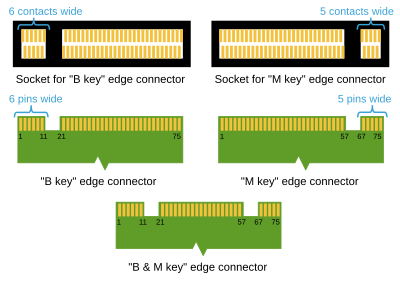Question Questions about ssd type?
- Thread starter PeyoteFTW
- Start date
You are using an out of date browser. It may not display this or other websites correctly.
You should upgrade or use an alternative browser.
You should upgrade or use an alternative browser.
An SSD has generally 2 different form factors (overall types):
There are also general PCIe M.2s that aren't labelled NVMe but also need a PCIe M.2 socket.
A standard SATA based M.2 requires an M.2 socket that is also SATA based.
Generally NVMe is faster as PCIe bandwidth is much bigger (faster data transfer) but in real world terms, the difference for applications is negligible as the application can only use the data so fast anyway.
The numbers (such as 2280) you see after an M.2 name or in the spec sheet is then the physical size of the M.2 (length). Then there are the keys.
Here is a quick idea for the keys

B key = PCIe x2 / SATA
M Key = PCIe x4 / SATA
A B+M is a keythat can operate with both.
Also just be wary of the interface you are using - see point 5 here:
https://forums.tomshardware.com/thr...when-selecting-parts-for-a-custom-pc.3510178/
- M.2
- 2.5 SSD (SATA)
- SATA
- PCIe
There are also general PCIe M.2s that aren't labelled NVMe but also need a PCIe M.2 socket.
A standard SATA based M.2 requires an M.2 socket that is also SATA based.
Generally NVMe is faster as PCIe bandwidth is much bigger (faster data transfer) but in real world terms, the difference for applications is negligible as the application can only use the data so fast anyway.
The numbers (such as 2280) you see after an M.2 name or in the spec sheet is then the physical size of the M.2 (length). Then there are the keys.
Here is a quick idea for the keys

B key = PCIe x2 / SATA
M Key = PCIe x4 / SATA
A B+M is a keythat can operate with both.
Also just be wary of the interface you are using - see point 5 here:
https://forums.tomshardware.com/thr...when-selecting-parts-for-a-custom-pc.3510178/
oblivioncth
Distinguished
There are also NVME drives that plug directly into native 4x PCI-e slots but their popularity was quickly squashed when M.2. became universally adopted.
TRENDING THREADS
-
-
-
-
-
Question CPU LED Stays On After Windows Installer BSOD — Ryzen 5 5600 on MSI B550-A PRO
- Started by 33P4BLO
- Replies: 2
-
Discussion What's your favourite video game you've been playing?
- Started by amdfangirl
- Replies: 4K

Space.com is part of Future plc, an international media group and leading digital publisher. Visit our corporate site.
© Future Publishing Limited Quay House, The Ambury, Bath BA1 1UA. All rights reserved. England and Wales company registration number 2008885.
